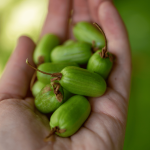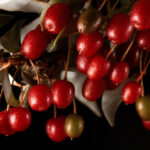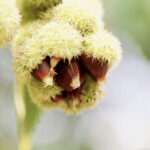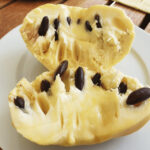Plant Profile: Pomegranate – The Jewel of the Orchard
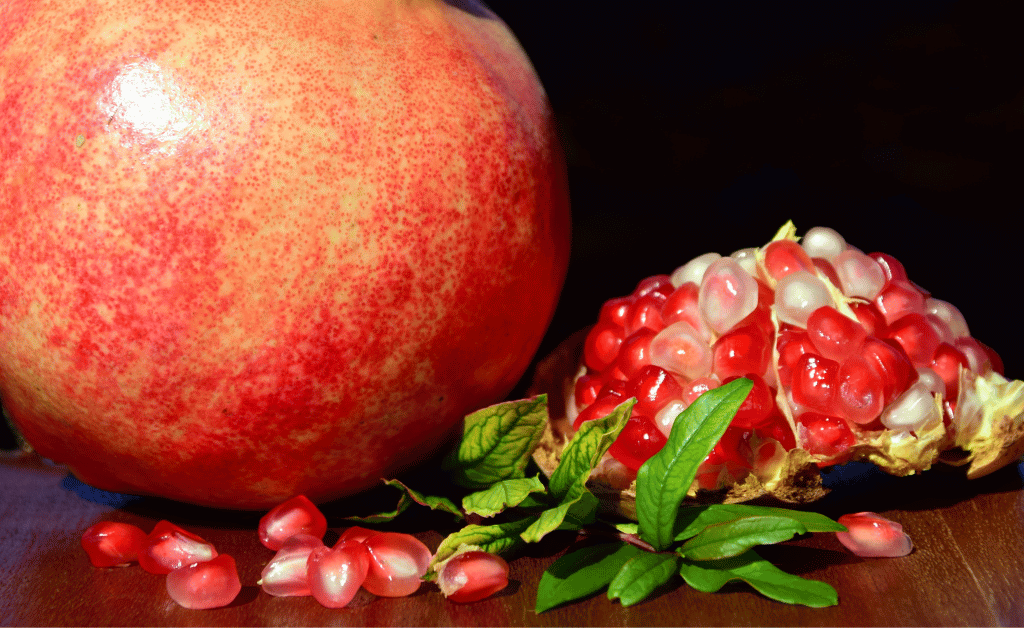
The pomegranate, scientifically known as Punica granatum, is also commonly referred to as the “fruit of paradise.” This deciduous shrub is renowned for its juicy, seed-filled arils.
Classification
- Kingdom: Plantae
- Family: Lythraceae
- Genus: Punica
- Species: P. granatum
Origin and Distribution
Originally from the region spanning modern-day Iran to northern India, pomegranates are now cultivated worldwide, particularly in Mediterranean climates.
USDA Hardiness Zones
Zones 7-12
Chill Hours Requirement
Approximately 100-200 chill hours are needed for optimal growth.
Growth Habits
- Height: 5-8 meters (16-26 feet)
- Width: 3-4 meters (10-13 feet)
- Growth Rate: Moderate
- Preferred Conditions: Full sun, well-drained soil
Role in a Food Forest
Canopy Layer
Benefits for Hugelkultur or Permaculture Systems
Pomegranates offer a multitude of advantages when integrated into Hugelkultur or permaculture systems:
Drought Resistance
One of the most notable traits of pomegranates is their drought resistance. This makes them particularly valuable in permaculture systems where water conservation is a priority. Their deep root systems allow them to access water from deeper soil layers, reducing the need for frequent irrigation.
Soil Enrichment
Pomegranate trees contribute to soil health by dropping their leaves, which decompose to add organic matter and nutrients back into the soil. This is especially beneficial in Hugelkultur systems, where soil fertility is enhanced through the decomposition of organic materials.
Pest Management
Pomegranates are relatively pest-resistant, reducing the need for chemical pesticides. This aligns well with the principles of permaculture, which emphasize natural and sustainable methods of pest control.
Polyculture Compatibility
In permaculture systems that employ polyculture, pomegranates can be planted alongside various other plants without competing aggressively for resources. This promotes biodiversity and creates a more resilient ecosystem.
Erosion Control
The extensive root system of the pomegranate also aids in soil stabilization, making it an excellent choice for sloping lands or areas prone to erosion.
Food Production
Beyond their environmental benefits, pomegranates are a valuable addition to any food forest. Their fruit can be harvested for various culinary uses, contributing to the system’s overall yield.
By incorporating pomegranates into your Hugelkultur or permaculture system, you not only gain a beautiful and fruitful plant but also contribute to a more sustainable and resilient ecosystem.
Culinary Uses
Pomegranates are not just a feast for the eyes; they are incredibly versatile in the culinary world as well. This fruit, native to the Middle East and North Africa, has found its way into various cuisines globally. Here’s an updated look at the culinary uses of pomegranate, drawing information from Wikipedia.
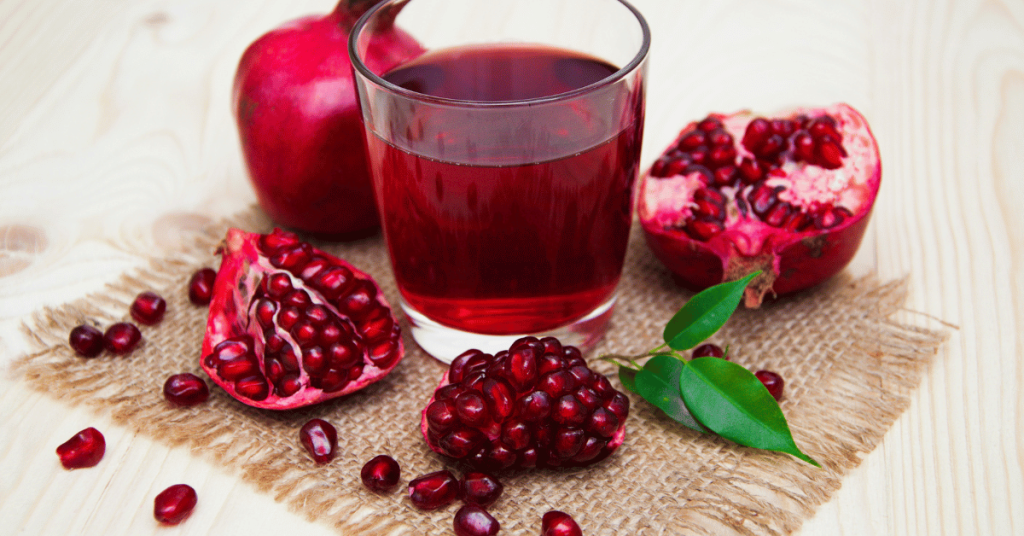
Traditional Uses
- Middle Eastern Cuisine: Pomegranate seeds and juice are commonly used in Middle Eastern dishes. They are often used in salads and as garnishes for desserts.
- Indian Cuisine: In India, the dried seeds, known as ‘anardana,’ are used as a spice in various dishes.
Modern Culinary Applications
- Juices and Smoothies: Pomegranate juice is a popular choice for health-conscious consumers. It can be blended into smoothies or consumed on its own.
- Salads: The seeds can add a pop of color and a burst of flavor to salads.
- Desserts: Pomegranate syrup or molasses is used in desserts like puddings and cakes.
Culinary Innovations
- Pomegranate Vinegar: This is a relatively new product that is gaining popularity for its unique flavor and potential health benefits.
- Pomegranate-Infused Spirits: Some distilleries are experimenting with pomegranate flavors in spirits like vodka and gin.
Cooking Techniques
- Reduction: Pomegranate juice can be reduced to a syrupy consistency and used as a glaze for meats.
- Marinades: The acidic nature of pomegranate juice makes it an excellent choice for marinades.
Pairing Suggestions
- Meats: Pomegranate pairs well with lamb, duck, and turkey.
- Vegetables: It complements the flavors of beets, carrots, and leafy greens.
Nutritional Aspects
- Antioxidants: Pomegranates are rich in antioxidants, which is one reason they are incorporated into health-focused recipes.
- Vitamins: They are a good source of Vitamin C and Vitamin K.
Conclusion
Pomegranates offer a plethora of culinary uses, from traditional dishes to modern innovations. Whether you are a home cook or a professional chef, this versatile fruit has something to offer for everyone.
Cultural Significance
The pomegranate has been a symbol of fertility and abundance in various cultures, a claim substantiated by multiple sources. According to a study published on NCBI, the pomegranate has been revered for its medicinal and symbolic properties since ancient times. It has been featured prominently in religious texts and mythologies, symbolizing life, fertility, and rebirth.
The Alimentarium also highlights the pomegranate’s role in various traditions and ceremonies. In some cultures, it is considered a miracle fruit that embodies characteristics of life and eternity.
Wikipedia’s entry on pomegranates further elaborates on its significance in art and literature, often being depicted as a symbol of prosperity and ambition.
Lastly, the Fertility and Pregnancy Edinburgh blog discusses the pomegranate’s association with fertility, even in modern alternative medicine practices, although such claims require scientific validation.
By understanding the rich cultural tapestry that surrounds the pomegranate, one gains a deeper appreciation for this remarkable fruit, beyond its culinary and environmental benefits.
Propagation and Care
Propagation is commonly done through hardwood cuttings. Water deeply but infrequently.
Pests and Diseases
Common pests include aphids and whiteflies. Use neem oil as a natural remedy.
Harvesting and Storage
Harvest in late summer to early fall. Store in a cool, dry place for up to 7 months.
Plant’s Lifespan
Perennial
Environmental Impact
Low; drought-resistance minimizes water usage.
Wildlife Attraction
Attracts pollinators like bees.
Companion Planting
Pairs well with mint and basil; avoid planting with potatoes.
Fun Facts
While the exact age of the pomegranate as a cultivated fruit is not specified, the pomegranate holds a venerable place in human history. According to a study published on NCBI, the pomegranate has been revered for its medicinal properties and features in the heraldic crests of several medical institutions. It has been held sacred by many of the world’s major religions, symbolizing life, fertility, and rebirth. The fruit probably originated in Iran and Afghanistan and has been much used in Zoroastrian ritual and domestic observances. In various cultures and religions, including Greek mythology, Zoroastrianism, Judaism, Buddhism, Christianity, and Islam, the pomegranate has been a symbol of sanctity, fertility, and abundance.
References and Further Reading
Explore the Journey of Pomegranate Trees Grown from Seed
If you’ve found this article enlightening and are keen to delve deeper into the fascinating world of pomegranates, we have just the read for you. Don’t miss our in-depth article on the resilient journey of our pomegranate trees grown from seed. This piece offers a firsthand experience of growing pomegranates, providing valuable insights that can guide you in your own gardening endeavors.
Read “The Resilient Journey of Our Pomegranate Trees Grown from Seed” on Hugelkultur Works
Whether you’re a seasoned gardener or a beginner, this article will enrich your understanding of pomegranates and inspire you to incorporate them into your own sustainable gardening practices.

